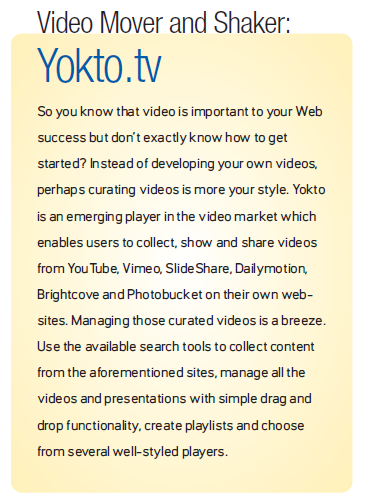Video Strategy: 5 Steps for Success

 Online retailers are moving quickly to include video on their websites. eMarketer reported that in 2010, 33 percent of retailers planned to add video to their websites within a year.
Online retailers are moving quickly to include video on their websites. eMarketer reported that in 2010, 33 percent of retailers planned to add video to their websites within a year.
That makes it a higher priority than any other site initiative.
In the rush to launch a new ecommerce feature it can be easy to lose sight of the key objectives, resulting in a disjointed video presence, lack of metrics and insufficient business impact. The best way to avoid that is to create a focused video strategy and ensure that everyone understands it.
The video strategy encompasses everything from goalsetting and logistics to identifying key decision-makers. Whether adding video to a website for the first time or augmenting an existing program, here are five steps for a successful video strategy.
1. Understand the Scope of the Project
In much the same way a company's mission statement guides its overall business practices, your video plan's vision will inform all elements of your video strategy.
Before you can dive into the details, you need to envision the scope of your video plan. Will you produce videos inhouse or work with a professional video provider? Before making your decision, consider the advantages and challenges of both options.
Regardless of which method you choose, a video strategy session should be the first step you take with your video team. In this meeting, steps two through five are discussed and documented.
2. Zoom in on the Details
Once you have a vision for the project and resources to make it a reality, you can hone in on the details. Ecommerce professionals know that adding a new feature entails many aesthetic, logistical and organizational components.
The video team should document requirements for branding, talent choices, scripting, audio, filming style and editing in an initial meeting. This enables the video team to move forward without having to go back to key decision-makers for feedback on each component.
Timeline and budget should be agreed upon during the strategy meeting as well. Setting an initial timeline gives urgency to the project. And since video can drive increased conversion as well as engagement and branding benefits, the longer you go without video, the more revenue you miss out on. Identifying who will be involved in the project is essential to ensure effective communication. I'll explain how to identify key stakeholders in step four.
3. Set Goals and Discuss Measurement
Setting goals upfront is one of the most vital parts of creating a video strategy. Without clear goals, there's a good chance of losing focus.
Understanding how success will be measured and reported influences your plan. As part of your strategy, decide what metrics you hope to impact. Depending on your goals, metrics to track could include view rate, time on site, pages per unique visitor, conversion rates and more.  Determine what metrics you'll monitor and set your reporting plan early in the process of laying out your video strategy. That way, key decision-makers and the video team will be clear on the expectations from the outset.
Determine what metrics you'll monitor and set your reporting plan early in the process of laying out your video strategy. That way, key decision-makers and the video team will be clear on the expectations from the outset.
4. Identify Stakeholders
Engage all appropriate parties when creating your strategy. Involve stakeholders from your ecommerce organization, communications team and site merchandisers to start.
Here's a good rule of thumb: if someone is responsible for the business results you'll be driving or the brand your videos will speak on behalf of, they're probably a stakeholder. Getting everyone on board early ensures that the program follows the right track.
5. Test and Learn
Remember when adding ratings and reviews to websites was new? Companies had to test different formats and placements to obtain the most customer involvement. Through this process, we've learned best practices and better understand consumer behavior. The same is applicable to video.
A good video strategy is solid, but doesn't discount the possibility of revision. If done well in the beginning, changes should be evolutionary and based on insights from the data that is collected. After deploying the videos, analyze what works, get rid of what doesn't and continue to progress. Strategy Leads to Success
Adding video to your website is not something done on a whim. It takes a meticulously planned and expertly executed video strategy. A good strategy guides the project and encourages new opportunities for growth. Follow these steps and your video strategy will provide a clear plan for a successful video program.
About the Author:
Craig Wax is the CEO of Invodo, leading the company's overall market strategy, product vision and investor relationships. He brings a seasoned general management perspective to guide Invodo's rapid growth. Craig is a frequent speaker at industry events such as the National Retail Federation's Big Show, the Shop.org Summit and Innovation Workshop, and eTail.











